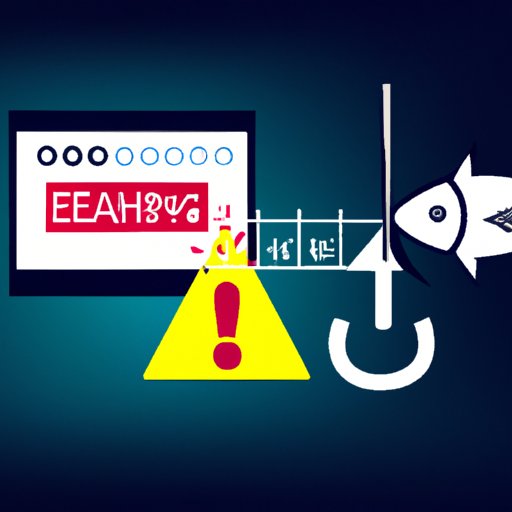Introduction
Phishing is a type of cyber attack that uses malicious emails or text messages to deceive users into providing sensitive information such as passwords, credit card numbers, or bank account details. The attacker then uses this information to access the victim’s accounts or systems. It is one of the most common types of cybercrime, and it can be used for various malicious purposes such as identity theft and financial fraud.
At its core, phishing is a form of social engineering. It relies on psychological manipulation to trick users into taking actions they normally wouldn’t, such as clicking on a malicious link or downloading a malicious attachment. Understanding how phishing works is the first step in protecting yourself from these scams.

Different Types of Phishing Attacks
There are several different types of phishing attacks, each with its own set of tactics and techniques. Here are some of the most common:
Malware-Based Attacks
In a malware-based attack, the attacker sends a malicious file or program as an attachment or link in the email. When the user clicks on the link or downloads the attachment, the malware is installed on their computer. The malware can then be used to steal data, take control of the system, or perform other malicious activities.
Spear Phishing
Spear phishing attacks are targeted at specific individuals or organizations. The attacker sends an email that appears to be from a trusted source, such as a friend, colleague, or business partner. The email contains a malicious link or attachment that, when clicked, installs malware on the victim’s computer.
Smishing
Smishing, or SMS phishing, is similar to spear phishing but uses text messages instead of emails. The attacker sends a text message that appears to be from a legitimate source, such as a bank or government agency. The message contains a malicious link or attachment that, when clicked, installs malware on the victim’s phone.
Identifying a Phishing Email
While phishing emails can be difficult to spot, there are certain clues that can help identify them. Here are some of the most common signs of a phishing email:
Suspicious Sender Address
One of the easiest ways to identify a phishing email is to check the sender address. If the address does not match the name of the alleged sender, then it is likely to be a scam. Additionally, if the address contains strange characters or symbols, it is also likely to be a phishing attempt.
Unusual Requests in the Content
Another way to identify a phishing email is to look for unusual requests in the content. For example, if the email is allegedly from your bank and asks you to click a link to “verify your identity” or “update your account information”, it is likely to be a phishing attempt.
Poorly Written Language
Phishing emails are often written in poor English, with grammatical and spelling mistakes. If an email from a supposedly reputable source contains these errors, it is likely to be a phishing attempt.

Tips for Protecting Yourself from Phishing Scams
Fortunately, there are steps you can take to protect yourself from phishing scams. Here are some tips to keep in mind:
Always Double Check Links
Before clicking any links in an email, always double check them. Hover your mouse over the link to see where it will take you before clicking on it. If the link looks suspicious or takes you to an unfamiliar website, do not click on it.
Do Not Open Attachments From Unknown Sources
Never open attachments from unknown sources, as they may contain malicious software. If you receive an email with an attachment from an unfamiliar sender, delete it immediately.
Be Wary of Unsolicited Emails
Be wary of unsolicited emails, even if they appear to be from a legitimate source. Always double check the sender address and look for any signs of a phishing attempt, such as poor grammar or spelling mistakes.
The Role of Social Engineering in Phishing Attacks
Social engineering is a key component of phishing attacks. Attackers use various tactics to manipulate victims into taking actions they normally wouldn’t. Here are some of the most common forms of social engineering used in phishing attacks:
Pretexting
Pretexting is a type of social engineering in which the attacker creates a false scenario or situation to gain the trust of the victim. For example, the attacker might pose as a customer service representative in order to get the victim to reveal sensitive information.
Tailgating
Tailgating is a type of social engineering in which the attacker follows a person into a secure area, such as a building or office. The attacker then uses the opportunity to gain access to sensitive information or systems.
Shoulder Surfing
Shoulder surfing is a type of social engineering in which the attacker watches someone enter a password or PIN number. The attacker then uses this information to gain access to the person’s accounts or systems.

Steps Organizations Can Take to Help Prevent Phishing Attacks
Organizations can take steps to help prevent phishing attacks. Here are some of the most effective measures:
Educate Employees About the Threat
Educating employees about phishing attacks is one of the most effective ways to prevent them. Employees should be taught how to recognize phishing emails and what to do if they receive one. Organizations should also emphasize the importance of not sharing sensitive information or clicking on suspicious links.
Invest in Security Software
Investing in security software can help organizations detect and block phishing emails before they reach employees. Anti-phishing software can also identify malicious links and attachments and alert employees to potential threats.
Establish Policies and Procedures
Organizations should also establish policies and procedures to help protect against phishing attacks. These policies should include guidelines for handling emails, such as not opening attachments from unknown senders and not clicking on suspicious links.
Conclusion
Phishing is a serious threat to both individuals and organizations. By understanding how phishing works and taking the necessary steps to protect yourself and your organization, you can help reduce the risk of becoming a victim of these scams.
(Note: Is this article not meeting your expectations? Do you have knowledge or insights to share? Unlock new opportunities and expand your reach by joining our authors team. Click Registration to join us and share your expertise with our readers.)
